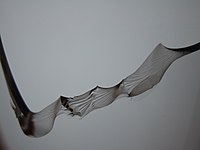
Photo from wikipedia
This paper investigates the microstructural characterization of the fracture propagation edge during laser beam welding of Ti6Al4V and 304 stainless steel using Cu, V, and Ni interlayers as a single… Click to show full abstract
This paper investigates the microstructural characterization of the fracture propagation edge during laser beam welding of Ti6Al4V and 304 stainless steel using Cu, V, and Ni interlayers as a single Cu interlayer and composite interlayer structures with different Cu interlayer thicknesses. This study attempts to increase the Ti-SS joint strength through the use of the composite interlayers. X-ray diffraction characterization based on a 0.5-mm-thick Cu interlayer showed that the SS/Cu/Ti joint contained considerable brittle IMCs; however, the fracture surface of the SS/Cu-V/Ti composite interlayer sample did not contain any Fe-Ti IMCs or Cr2Ti. EBSD observation indicated that the crack propagated transgranularly from solidified CuTi in the interdendritic regions of the FeTi compounds in the composite interlayer sample; however, the crack propagated intergranularly along Fe2Ti grain boundaries in the single interlayer sample. The investigation based on a 1-mm-thick Cu interlayer showed that the SS/Ni-Cu1/Ti sample was stronger than the SS/Cu1/Ti sample due to a lack of CuTi at 3.5 kW. The tensile strength of the SS/Cu1-V/Ti joint was greater than that of the SS/Ni-Cu1/Ti joint due to the formation of ductile NiTi instead of brittle NiTi2. The microstructures of the fracture edges after tensile testing illustrated that the eutectic CuTi + CuTi2 fractured at the SS/Cu1/Ti joint after tensile testing, while CuTi2 and eutectoid αTi + CuTi2 compounds fractured during the tensile experiment at the SS/Ni-Cu1/Ti and SS/Cu1-V/Ti joints, respectively. Investigations based on both the 0.5- and 1-mm-thick Cu interlayers showed that the tensile strength and elongation of the composite interlayer joints at a laser power of 3.5 kW were greater than those of the single interlayer joints.
Journal Title: Journal of Materials Engineering and Performance
Year Published: 2018
Link to full text (if available)
Share on Social Media: Sign Up to like & get
recommendations!